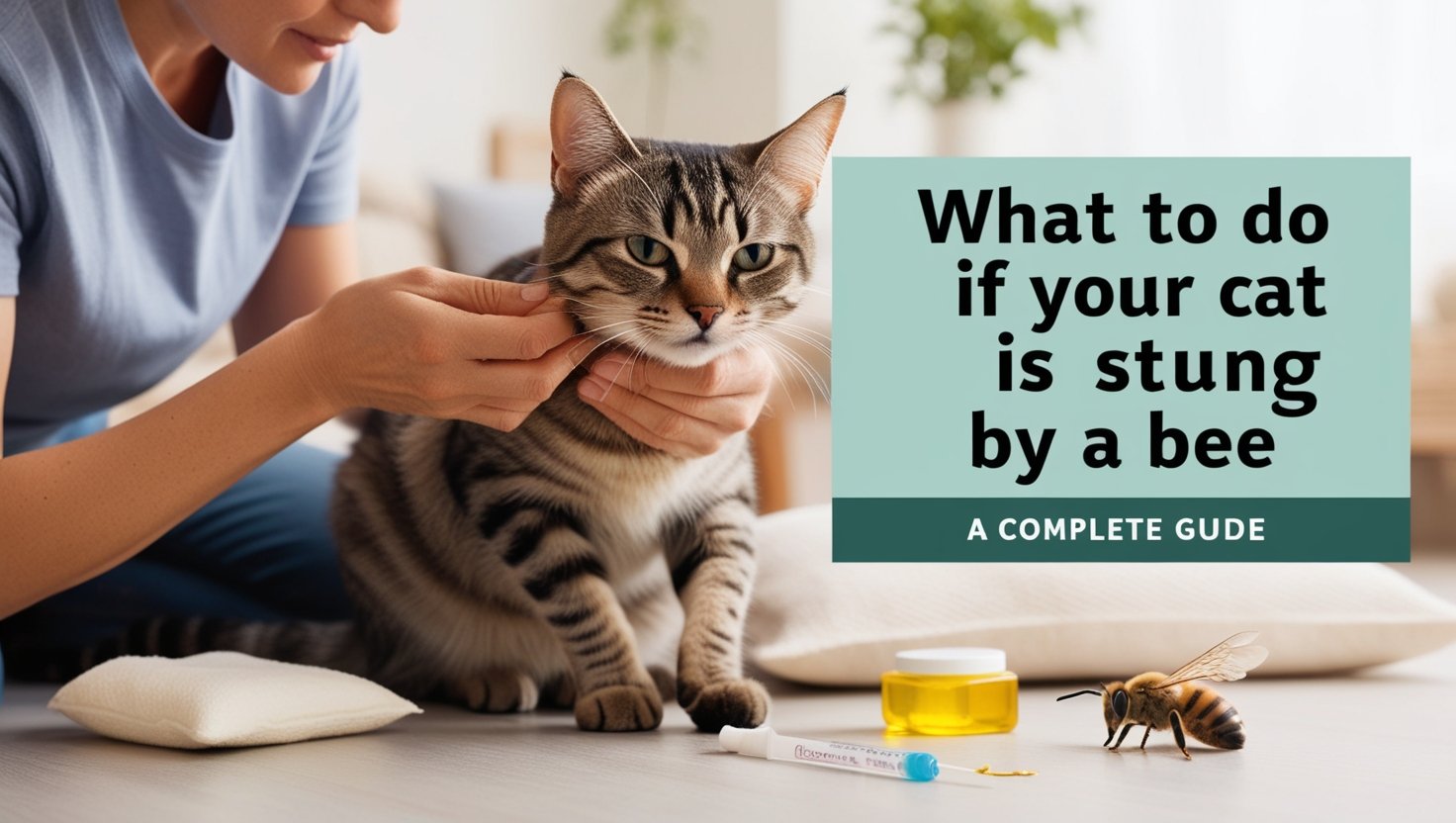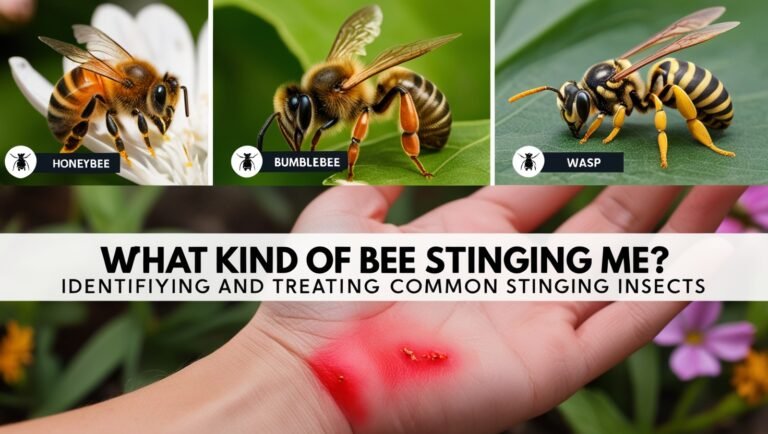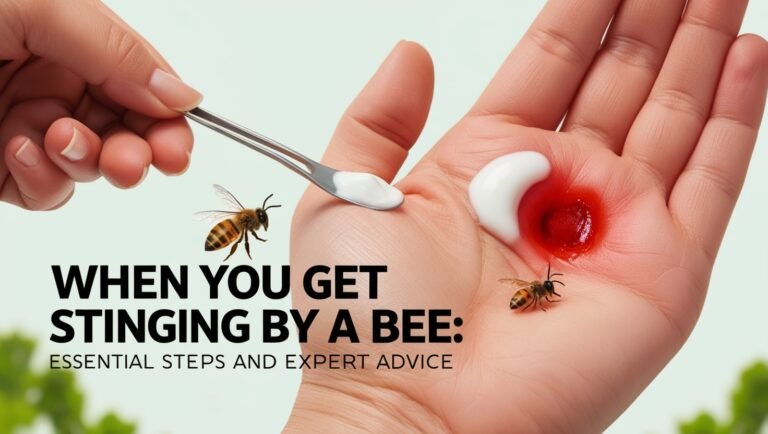What to Do if Your Cat is Stung by a Bee: A Complete Guide

If your cat has been stung by a bee, don’t panic. Most bee stings in cats are painful but not life-threatening. Remove the stinger if visible, apply a cold compress to reduce swelling, and monitor your cat closely for signs of an allergic reaction. For severe reactions or multiple stings, contact your vet immediately. This guide will walk you through everything you need to know to help your feline friend recover from a bee sting quickly and safely.
Understanding Bee Stings in Cats
Bee stings in cats are more common than you might think, especially during warmer months when bees are most active. To effectively help your cat, it’s crucial to understand why these stings happen and where they’re most likely to occur.
Why Do Bees Sting Cats?
Bees don’t set out to sting cats. In fact, they’d rather avoid it. Bees sting as a defense mechanism when they feel threatened. Your curious cat might swat at a bee, thinking it’s a fun new toy, only to receive a painful surprise in return.
Bees release a pheromone after stinging that can attract other bees, potentially leading to multiple stings. This is why it’s important to remove your cat from the area quickly if you suspect a bee sting.
Common Areas Where Cats Get Stung
Cats are most likely to be stung on their:
- Paws
- Face (especially nose and mouth)
- Belly (if they roll on a bee)
These areas are where cats are most likely to come into contact with bees during play or exploration. Paw stings are common because cats often bat at bees with their paws.
Recognizing the Signs of a Bee Sting in Cats
Knowing what to look for can help you quickly identify if your cat has been stung by a bee. Some signs are immediate, while others may develop over time.
Immediate Reactions to Watch For
If your cat has just been stung, you might notice:
- Sudden yelping or meowing
- Pawing at the affected area
- Limping (if stung on a paw)
- Swelling at the sting site
- Excessive licking of the affected area
Delayed Symptoms That May Appear
In the hours following a sting, keep an eye out for:
- Continued swelling
- Lethargy
- Loss of appetite
- Drooling
- Difficulty breathing (in severe cases)
If you notice any of these delayed symptoms, especially difficulty breathing, contact your veterinarian immediately.
Step-by-Step Guide: What to Do if Your Cat is Stung by a Bee
Quick action can make a big difference in your cat’s comfort and recovery. Here’s what to do if you suspect your cat has been stung by a bee.
Assessing the Situation
- Stay calm. Your cat will pick up on your stress.
- Look for the bee. If it’s still around, carefully remove your cat from the area to prevent more stings.
- Check for signs of a sting, like swelling or your cat pawing at an area.
Removing the Stinger Safely
If you can see the stinger, remove it promptly. Here’s how:
- Use a credit card or similar flat object.
- Gently scrape across the skin to remove the stinger.
- Don’t use tweezers, as squeezing the venom sac can release more venom.
Remember, cats often remove the stinger themselves through grooming. If you can’t find it, don’t worry too much.
Treating the Sting Site at Home
For mild stings:
- Apply a cold compress to reduce swelling. Wrap an ice pack in a towel and hold it to the area for a few minutes at a time.
- Make a paste of baking soda and water. Apply it to the sting site to help neutralize the venom.
- Keep your cat from licking the area excessively. An e-collar might be necessary.
Monitoring Your Cat After a Bee Sting
Watch your cat closely for the next 24 hours. Look for:
- Changes in behavior
- Difficulty breathing
- Excessive swelling
- Loss of appetite
If you notice any of these signs, contact your vet immediately.
When to Seek Veterinary Care for a Cat Stung by a Bee
While many bee stings can be managed at home, some situations require professional medical attention.
Signs of an Allergic Reaction
Get to a vet immediately if you notice:
- Difficulty breathing
- Severe swelling, especially around the face or neck
- Vomiting or diarrhea
- Collapse or extreme weakness
- Pale gums
These could be signs of anaphylaxis, a severe allergic reaction that can be life-threatening.
Multiple Stings: A Greater Risk
If your cat has been stung multiple times, seek veterinary care regardless of symptoms. Multiple stings mean more venom, which can overwhelm your cat’s system.
Potential Complications of Bee Stings in Cats
While most bee stings are just painful nuisances, they can sometimes lead to more serious issues.
Anaphylaxis: A Life-Threatening Emergency
Anaphylaxis is a severe allergic reaction that can occur within minutes of a sting. Symptoms include:
- Sudden difficulty breathing
- Swelling of the throat or tongue
- Vomiting
- Diarrhea
- Collapse
If you suspect anaphylaxis, this is an emergency. Get to a vet immediately.
Secondary Infections and Other Concerns
Sometimes, the sting site can become infected. Watch for:
- Increased redness or swelling after 2-3 days
- Discharge from the sting site
- Fever
In rare cases, bee stings near the eye can cause eye damage. If your cat is stung near the eye, consult a vet even if other symptoms are mild.
Treating Bee Stings in Cats: Home Remedies vs. Veterinary Care
Knowing when to treat at home and when to seek professional help is crucial for your cat’s well-being.
Safe Home Treatments for Mild Stings
For mild stings without signs of allergic reaction:
- Cold compress: Apply for 10 minutes at a time to reduce swelling.
- Baking soda paste: Mix baking soda with a little water and apply to the sting site.
- Keep the area clean: Gently clean with mild soap and water if needed.
- Prevent licking: Use an e-collar if necessary to prevent your cat from irritating the area.
When Professional Medical Care is Necessary
Seek veterinary care if:
- Your cat shows signs of an allergic reaction
- There are multiple stings
- The sting is near the eye, mouth, or throat
- Symptoms worsen after 24 hours
- You’re unsure about the severity
A vet can provide antihistamines, pain relief, and other treatments if needed.
Preventing Bee Stings in Cats
Prevention is always better than cure. Here are some ways to reduce the risk of bee stings for your feline friend.
Creating a Bee-Safe Environment for Your Cat
- Remove bee-attracting plants from your yard, especially near areas your cat frequents.
- Keep garbage cans sealed to avoid attracting bees.
- Fill in ground holes where ground bees might nest.
- Consider professional removal if you have a bee hive on your property.
Training Your Cat to Avoid Bees
While it’s challenging to train cats not to chase insects, you can:
- Use a spray bottle to discourage your cat from approaching bees.
- Provide plenty of indoor enrichment to reduce outdoor exploration.
- Supervise outdoor time, especially during peak bee hours (early morning and late afternoon).
Bee Stings vs. Other Insect Stings in Cats
Not all insect stings are created equal. Understanding the differences can help you respond appropriately.
Differences Between Bee, Wasp, and Hornet Stings
- Bee stings: Bees leave their stinger behind and die after stinging. The venom is acidic.
- Wasp and hornet stings: These insects can sting multiple times. Their venom is alkaline.
- Ant bites: Fire ants can both bite and sting, potentially causing multiple wounds.
Unique Concerns for Each Type of Sting
- Bee stings: Focus on removing the stinger quickly.
- Wasp and hornet stings: These can be more painful and may require more aggressive treatment for pain.
- Ant bites: Multiple bites can lead to significant swelling and pain.
For all insect stings, watch for signs of allergic reaction.
Myths and Facts About Cats and Bee Stings
Misinformation can lead to improper treatment. Let’s debunk some common myths and reinforce important facts.
Common Misconceptions Debunked
Myth: Cats can’t be allergic to bee stings. Fact: Cats can indeed have allergic reactions, including life-threatening anaphylaxis.
Myth: You should use tweezers to remove a bee stinger. Fact: Scraping with a credit card is safer, as tweezers might squeeze more venom into the wound.
Myth: If the swelling goes down, your cat is fine. Fact: Some allergic reactions can occur hours after the sting. Always monitor your cat for 24 hours.
Science-Backed Information You Should Know
- Bee venom contains proteins that can trigger an immune response in cats.
- The severity of a sting can vary based on the cat’s size, the number of stings, and individual sensitivity.
- Cats with prior bee sting exposure may have more severe reactions to subsequent stings.
Long-Term Effects: Can a Bee Sting Cause Lasting Issues in Cats?
While most cats recover fully from bee stings, it’s important to understand potential long-term impacts.
Potential Long-Term Health Concerns
In rare cases, bee stings can lead to:
- Increased sensitivity to future stings
- Chronic skin irritation at the sting site
- Psychological effects (fear of outdoors or insects)
Follow-Up Care After a Severe Sting
If your cat experienced a severe reaction:
- Schedule a follow-up vet appointment to ensure full recovery.
- Discuss allergy testing with your vet.
- Consider keeping an epi-pen on hand for future emergencies.
- Be extra vigilant during bee season.
Let’s Finish
Knowing what to do if your cat is stung by a bee can make a world of difference in your pet’s comfort and safety. Quick action, careful monitoring, and knowing when to seek professional help are key. Remember, most bee stings in cats are painful but not serious. However, always err on the side of caution and consult your vet if you’re unsure.
By understanding the risks, recognizing the signs, and knowing how to respond, you’re well-equipped to handle this common feline mishap. Keep this guide handy, and you’ll be prepared to spring into action if your curious cat ever has an unfortunate encounter with a bee.
Stay vigilant, keep your cat safe, and enjoy watching your feline friend explore the world around them – just maybe with a little less bee chasing in the future!




